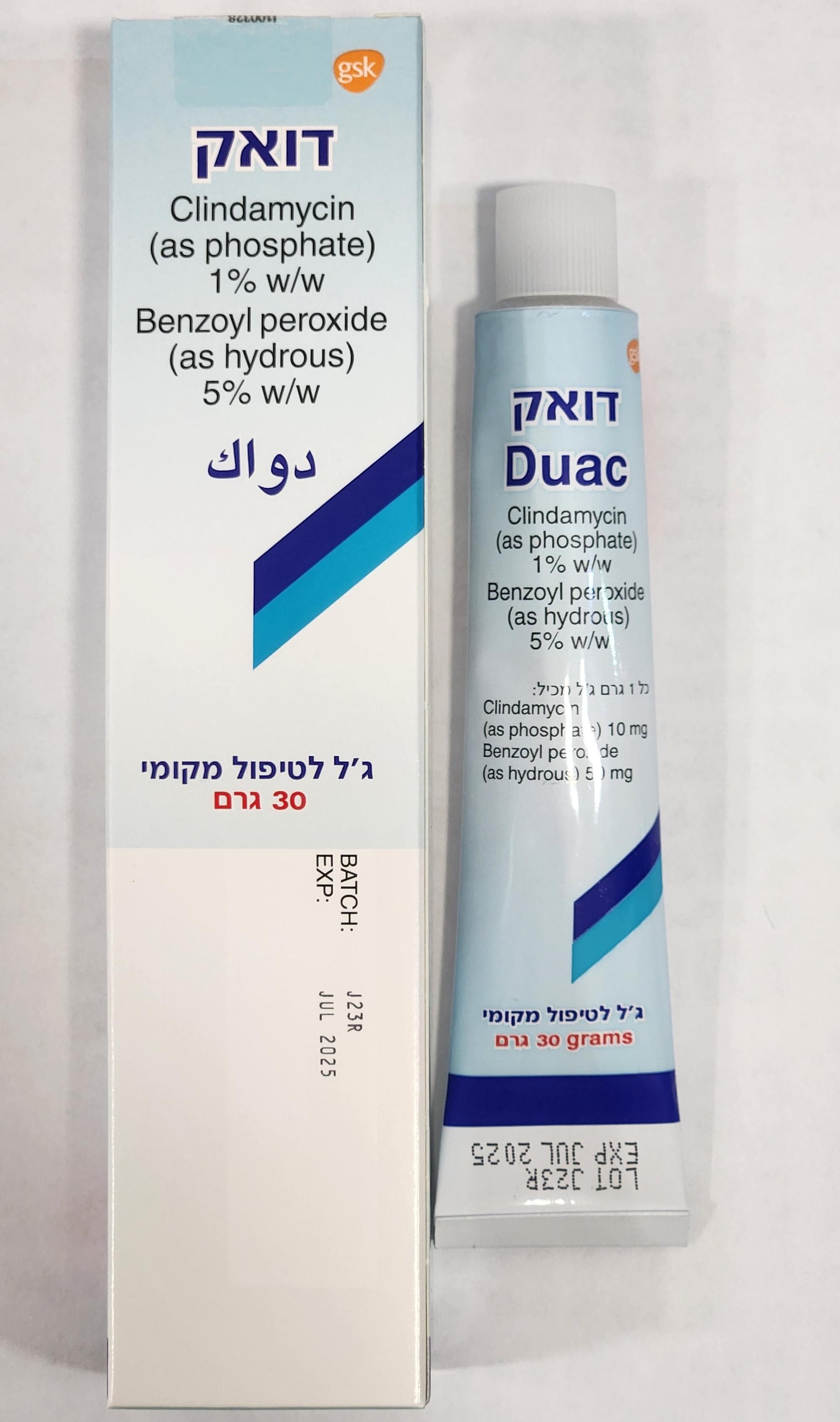Quest for the right Drug

דואק DUAC (BENZOYL PEROXIDE AS HYDROUS, CLINDAMYCIN AS PHOSPHATE)
תרופה במרשם
תרופה בסל
נרקוטיקה
ציטוטוקסיקה
צורת מתן:
חיצוני : TOPICAL
צורת מינון:
ג'ל : GEL
עלון לרופא
מינוניםPosology התוויות
Indications תופעות לוואי
Adverse reactions התוויות נגד
Contraindications אינטראקציות
Interactions מינון יתר
Overdose הריון/הנקה
Pregnancy & Lactation אוכלוסיות מיוחדות
Special populations תכונות פרמקולוגיות
Pharmacological properties מידע רוקחי
Pharmaceutical particulars אזהרת שימוש
Special Warning עלון לרופא
Physicians Leaflet
Adverse reactions : תופעות לוואי
4.8 Undesirable effects Adverse drug reactions (ADRs) are summarized below for Duac Gel as a combination including any additional ADRs that have been reported for the single topical active ingredients, benzoyl peroxide or clindamycin. Adverse drug reactions are listed by MedDRA system organ class and by frequency. Frequencies are defined as: very common (≥1/10); common (≥1/100 and <1/10); uncommon (≥1/1,000 and <1/100); rare (≥1/10,000 and <1/1,000) and not known (cannot be estimated from the available data). MedDRA SOC Very Common Common Uncommon Not known** Immune system Allergic reactions disorders including hypersensitivity and anaphylaxis Nervous system Paraesthesia disorders* Gastrointestinal Colitis (including disorders pseudomembranous colitis), hemorrhagic diarrhea, diarrhea, abdominal pain Skin and Erythema, Burning Dermatitis, Urticaria subcutaneous tissue peeling, dryness sensation pruritus, disorders* (Generally erythematous reported as rash, ‘mild’ in worsening of severity) acne General disorders Application site reactions and Administration including skin site conditions discoloration *At site of application. **Based on post-marketing reports. Since these reports are from a population of uncertain size and are subject to confounding factors, it is not possible to reliably estimate their frequency however, systemic reactions are rarely seen. In addition to the ADRs reported in the table above, in the pivotal trial conducted with topical clindamycin 1%/benzoyl peroxide 3% gel, application site photosensitivity reaction was also reported commonly. Also in addition to the ADRs reported above, in studies conducted with topical clindamycin alone, headache and application site pain were reported commonly. Local Tolerability During the five clinical trials with Duac Gel, all patients were graded for facial erythema, peeling, burning, and dryness on the following scale: 0 = absent, 1 = mild, 2 = moderate and 3 = severe. The percentage of patients that had symptoms present before treatment (at baseline) and during treatment were as follows: Local Tolerability Assessments for Subjects (N=397) in the Duac Gel Group during the Phase 3 Studies Before Treatment (Baseline) During Treatment Mild Moderate Severe Mild Moderate Severe Erythema 28% 3% 0 26% 5% 0 Peeling 6% <1% 0 17% 2% 0 Burning 3% <1% 0 5% <1% 0 Dryness 6% <1% 0 15% <1% 0 Reporting of suspected adverse reactions Reporting suspected adverse reactions after authorisation of the medicinal product is important. It allows continued monitoring of the benefit/risk balance of the medicinal product. Any suspected adverse events should be reported to the Ministry of Health according to the National Regulation by using an online form https://sideeffects.health.gov.il Additionally, you can also report to Padagis.co.il.

שימוש לפי פנקס קופ''ח כללית 1994
לא צוין
תאריך הכללה מקורי בסל
לא צוין
הגבלות
לא צוין
מידע נוסף
